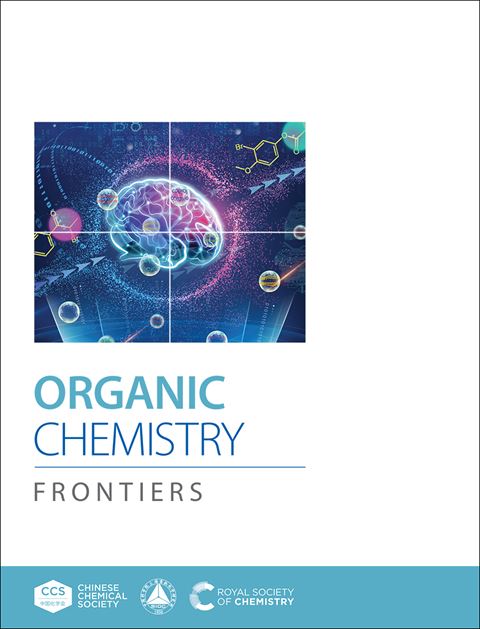催化剂控制的5-外显子和6-内环化:吲哚啉酮和二氢喹啉酮的区域发散性
IF 4.6
1区 化学
Q1 CHEMISTRY, ORGANIC
引用次数: 0
摘要
五元和六元苯融合内酰胺是许多天然产物和生物活性化合物中重要和普遍的支架。尽管在合成方面取得了相当大的进展,但分子内烯烃功能化倾向于经历5-外三角环化以获得五元环产物,而动力学上不利的6-内三角环化在很大程度上仍然难以实现。在此,我们报道了一种新的催化剂控制的5-外/6-内链区域分散的分子内芳基氨基烷基化。本方法从同样简单的起始材料同时得到多种五元和六元n杂环,这两种产物在有机合成中都是非常有用的基石。计算结果表明,烷基自由基对金属中心的亲和是导致区域选择性发散的主要因素。与Pd中心相比,Ni中心的键亲和力更强,导致Ni催化反应以C-Br键裂解为起始,通过外球单电子转移(OSET)途径得到芳基自由基,而Pd催化反应以α-氨基自由基在烯烃末端的ese加成为起始。本文章由计算机程序翻译,如有差异,请以英文原文为准。
Catalyst-Controlled 5-exo and 6-endo Cyclization: Regiodivergent Access to Indolinones and Dihydroquinolinones
Five- and six-membered benzo-fused lactams are important and prevalent scaffolds in many natural products and biologically active compounds. In spite of considerable advances toward their synthesis, the intramolecular alkene functionalization preferably undergoes 5-exo-trig cyclization to afford five-membered ring products, while the kinetically disfavored 6-endo-trig cyclization remains largely elusive. Herein, we reported a novel catalyst-controlled 5-exo/6-endo regiodivergent intramolecular aryl-aminoalkylation of alkenes. The present method affords a variety of five- and six-membered N-heterocycles simultaneously from the same simple starting materials, both products are very useful building blocks in organic synthesis. The computations reveal that the bonding affinity of the alkyl radical to the metal center is the primary factor behind the divergent regioselectivity. The stronger bonding affinity to the Ni center, compared to the Pd center, causes the Ni-catalyzed reaction to initiate with C‒Br bond cleavage to get aryl radical via outer-sphere single electron transfer (OSET) pathway, while the Pd-catalyzed reaction begins with the Giese addition of α-amino radical to the terminal position of alkenes.
求助全文
通过发布文献求助,成功后即可免费获取论文全文。
去求助
来源期刊

Organic Chemistry Frontiers
CHEMISTRY, ORGANIC-
CiteScore
7.90
自引率
11.10%
发文量
686
审稿时长
1 months
期刊介绍:
Organic Chemistry Frontiers is an esteemed journal that publishes high-quality research across the field of organic chemistry. It places a significant emphasis on studies that contribute substantially to the field by introducing new or significantly improved protocols and methodologies. The journal covers a wide array of topics which include, but are not limited to, organic synthesis, the development of synthetic methodologies, catalysis, natural products, functional organic materials, supramolecular and macromolecular chemistry, as well as physical and computational organic chemistry.
 求助内容:
求助内容: 应助结果提醒方式:
应助结果提醒方式:


